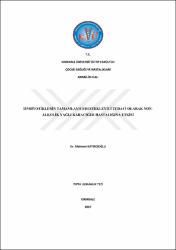| dc.contributor.advisor | Katırcıoğlu, Yazar:Mehmet | |
| dc.contributor.author | Katırcıoğlu, Mehmet | |
| dc.date.accessioned | 2021-01-16T19:13:15Z | |
| dc.date.available | 2021-01-16T19:13:15Z | |
| dc.date.issued | 2017 | |
| dc.identifier.uri | | |
| dc.identifier.uri | https://hdl.handle.net/20.500.12587/17214 | |
| dc.description | YÖK Tez ID: 466531 | en_US |
| dc.description.abstract | Giriş Aşırı alkol alımı olmadan karaciğerde fazla yağ birikimi olması şeklinde tanımlanan non-alkolik yağlı karaciğer hastalığı (NAYKH) kronik karaciğer hastalığının en sık nedenidir. Diyetle ilişkili faktörler ve bağırsak bakteriler sıklığı giderek artan obezite ve obeziteyle ilişkili olan karaciğer yağlanması ve insülin direnci gibi durumlarda önemli rol oynamaktadır. Bu çalışmada ratlarda, sinbiyotiklerin diyet kaynaklı NAYKH ve kilo artışı üzerindeki etkisini değerlendirdik. Gereç ve yöntem Erkek Wistar Albino cinsi ratlar 60 gün boyunca yüksek yağ ve şeker içerikli diyetle beslendi. 8 hafta sonra ratlar her grupta en az 6 tane olacak şekilde rastgele iki gruba ayrıldı: kontrol grubuna standart diyet verilirken sinbiyotik grubuna standart diyete ek olarak 15 gün boyunca sinbiyotik verildi. Verilen sinbiyotik Lactobacillus casei, Lactobacillus acidophilus, Bifidobacterium animalis ssp lactis B94 (1X109 CFU/gün) ve fruktooligosakkaridden oluşmaktaydı. 0, 60 ve 75.günlerde vücut ağırlıkları alanin amino transferaz (ALT) ve aspartat aminotransferaz (AST) enzim düzeyleri ölçüldü. 60.günde karaciğer ultrasonografisiyle hepatosteatoz varlığı doğrulandı. 75.günden sonra ratlar anestezi altında sakrifiye edildi, histopatolojik analizler için karaciğer dokuları çıkarıldı. Bulgular Başlangıçta ve 60.günde gruplar arasında vücut ağırlığı, ALT ve AST seviyeleri açısından farklılık yoktu. 75.günde sinbiyotik grubunda vücut ağırlığı ve ALT seviyelerinde kontrol grubuna kıyasla belirgin düşüş görüldü, ancak AST seviyeleri açısından farklılık yoktu. Histopatolojik analizlerde hepatosteatozis şiddetinin 'sinbiyotik almayan' kontrol grubunda belirgin olduğu görüldü. Sonuç Bulgularımız laktobasil ve bifidobakteri temelli sinbiyotik karışımının yüksek yağ ve şeker içerikli diyetle oluşturulan hepatosteatoz ve kilo alımını azaltmada etkin olduğunu göstermiştir. Bu sonuçlar sinbiyotiklerin NAYKH'ı tedavi etme/önlemede etkin olduğuna işaret etmektedir. Anahtar kelimeler: Sinbiyotik, hepatosteatoz, rat, vücut ağırlığı, yağlı karaciğer | en_US |
| dc.description.abstract | Introduction Non-alcoholic fatty liver disease (NAFLD), defined by excess fat accumulation in the liver without a history of excessive alcohol intake, is the most common causes of chronic liver disease. Dietary factors and intestinal bacteria play an important role in the rapidly increasing incidence of obesity and its associated conditions, such as steatosis and insulin resistance. In the current study, we evaluated the effect of synbiotics on diet-induced NAFLD and weight gain in rats. Material and methods Male Wistar Albino rats were fed a high sugar and high fat diet for 60 days. After 8 weeks, rats are randomly allocated in two groups (at least n=6) as follows: control group, receiving standart diet; and synbiotic groups, receiving standart diet and synbiotic for 15 days. Synbiotic consisted of Lactobacillus casei, Lactobacillus acidophilus, Bifidobacterium animalis ssp lactis B94 and fructooligosaccharide (1X109 CFU/day). Body weight, ALT and AST levels were measured on 0, 60 and 75 days. On day 60, the presence of hepatosteatosis was confirmed by liver ultrasonography. After 75 days, rats were sacrificed under anaesthesia, with liver tissue extracted for histopathological analyzes. Results At baseline and day 60, there was no significant difference in body weight, ALT and AST levels between groups, however in day 75, there was a significant decreases in ALT activity, and body weight in the synbiotic group compared to the control group but not in AST levels. Histopathological analyzes showed that the severity of hepatosteatosis was more pronounced in the non-synbiotic control group. Conclusion Overall, our data indicate that the Lactobacillus and Bifidobacterium based synbiotic mixture is effective in reducing the hepatosteatosis and weight gain with high fat and sugar intake, suggesting its possible therapeutic/preventive utilization for NAFLD Key words: Synbiotic, hepatosteatosis, rat, body weight, fatty liver | en_US |
| dc.language.iso | tur | en_US |
| dc.publisher | Kırıkkale Üniversitesi | en_US |
| dc.rights | info:eu-repo/semantics/openAccess | en_US |
| dc.subject | Çocuk Sağlığı ve Hastalıkları | en_US |
| dc.subject | Child Health and Diseases | en_US |
| dc.subject | | en_US |
| dc.subject | | en_US |
| dc.subject | | en_US |
| dc.subject | | en_US |
| dc.subject | | en_US |
| dc.subject | | en_US |
| dc.subject | | en_US |
| dc.subject | | en_US |
| dc.subject | | en_US |
| dc.subject | | en_US |
| dc.subject | | en_US |
| dc.title | Sinbiyotiklerin tamamlayıcı/destekleyici tedavi olarak non-alkolik yağlı karaciğer hastalığına etkisi | en_US |
| dc.title.alternative | Effects of Synbiotics on non-alcoholic fatty liver disease as a complementary / supportive treatment | en_US |
| dc.type | specialistThesis | en_US |
| dc.contributor.department | KKÜ, Tıp Fakültesi, | en_US |
| dc.identifier.startpage | 1 | en_US |
| dc.identifier.endpage | 76 | en_US |
| dc.relation.publicationcategory | Tez | en_US |
















